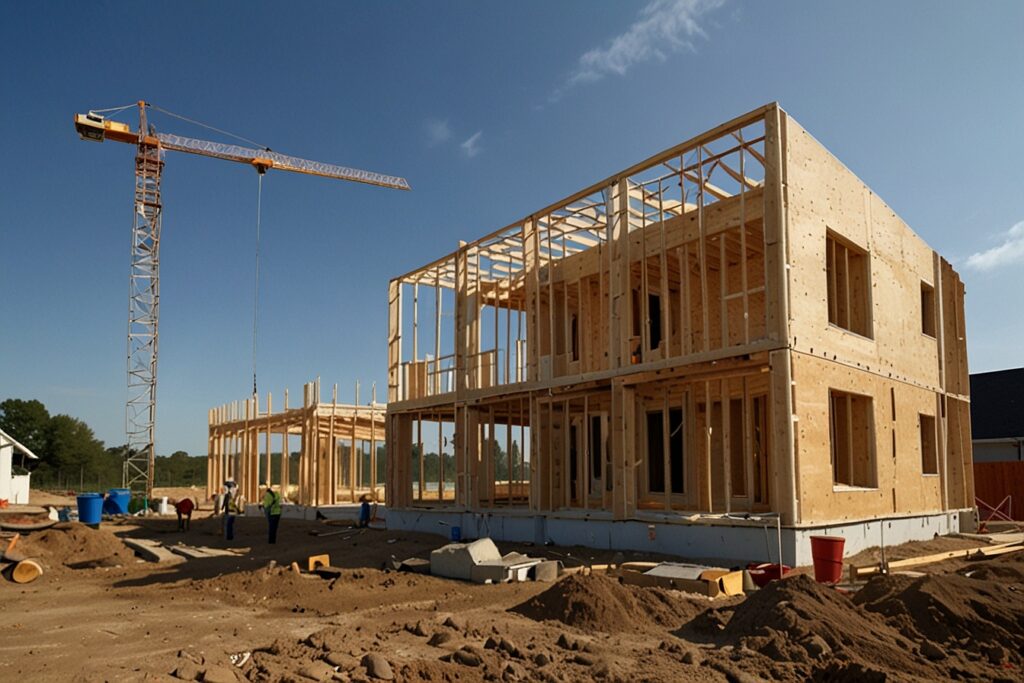
If you’re planning to create a new home in 2025, a one-time close construction loan, sometimes referenced as single close construction loan, might be the most convenient way to merge construction financing and permanent mortgage financing into a single transaction. With 2025 around the corner, it’s important to know current trends with interest rates, why rates are the way that they are and what could be coming up the pike for borrowers.
What Is a One-Time Close Construction Loan?
A one-time close construction loan simplifies the financing process by combining the construction loan and permanent mortgage into one loan and one closing. You’ll have only one application, one underwriting process and one set of closing costs to pay. You make interest-only payments during construction; after the home is built, the loan either converts to a 15- or 30-year mortgage. (CrossCountry Mortgage, New American Funding, Space Coast Credit Union)
There are several advantages to this structure, too, such as less paperwork, a more straightforward setup for loans and the option of locking in your interest rate from the very beginning. (CrossCountry Mortgage, Texas Regional Bank)
How Much Higher Are These Rates?
One-time close construction loans may have higher rates than traditional mortgages. For example:
- FHA construction loans often come with interest rates 2% to 4% higher than current mortgage rates due to higher perceived risk. (The Mortgage Reports)
- Conventional construction loans tend to have rates around 1% higher than standard mortgages. (The Mortgage Reports)
- In late 2024, experts expected one-time close rates to hover in the mid-6% range.
In 2025, construction-to-permanent loan rates are generally between approximately 6.9% and 8.2% for a 30-year term. (Trident Home Loans)
2025 Outlook: What Borrowers Can Expect
National Benchmark Rates
- Early 2025 fixed-rate construction loans are typically in the range of 7.0% to 8.5%.
- Adjustable-rate alternatives may vary between 6.5 percent and 7.9 percent. (Trident Home Loans)
So figure one-time close construction loans probably range in a similar area, depending on loan type and your qualifications as a borrower.
Government-Backed Programs
- VA one-time close loans: Or, generally in the range of 6.0% to 7.25%, with appealing terms for both veterans and active-duty military. (Trident Home Loans)
- FHA one-time close loans: Moderately higher than VA rates but still the same level of competitive, particularly for first-time or lower-credit score borrowers. (Trident Home Loans, The Mortgage Reports)
Such programs make higher interest rates competitive because they lower the bar to qualification or the amount of down payment required.
Regional and Loan Type Variations
- Residential vs. Commercial: Residential rates typically average 6.7%–8.8%, commercial projects can eclipse 10%, based on size, complexity and risk. (Trident Home Loans)
- Regional disparities: Rates there match the rest of the nation but lean towards the upper-end (6.9%–8.4%) because of great demand on housing, such as in Georgia (e.g., Atlanta metro). (Trident Home Loans)
To some extent, the Fund’s performance may be influenced by larger market trends and general economic conditions.
Market Trends and Broader Economic Drivers
Economists predict that construction rates, and mortgage rates along with them, will gradually taper as the Fed in 2025 starts to unwind the federal funds rate, though the upside impact likely lags, such as slower improvements in nonresidential construction, not materializing until 2026. (Modern Contractor Solutions)
By contrast, housing markets will stay tight, with mortgage rates averaging north of 6%, perhaps around 6.5% at the start of the year, before gradually softening later in 2025. (MarketWatch, New York Post)
Lenders themselves are cautiously optimistic, expecting bettering loan activity and profitability as rate pressures ease up the amount. (Independent Banker)
Summary Table: Rate Expectations for One-Time Close Loans in 2025
| Loan Type | Interest Rate (2025) | Notes |
| Fixed-rate construction loans | ~7.0%–8.5% | Consistent with national averages (Trident Home Loans) |
| Adjustable-rate construction | ~6.5%–7.9% | Flexible option, lower starting rate (Trident Home Loans) |
| 30-year construction-to-permanent | ~6.9%–8.2% | Typical single-close loan range (Trident Home Loans) |
| FHA one-time close | ~2%–4% above typical mortgage | Higher due to risk, depends on borrower profile (The Mortgage Reports, onetimeclose.com) |
| VA one-time close | ~6.0%–7.25% | More favorable for veterans (Trident Home Loans) |
| Regional (e.g., Georgia) | ~6.9%–8.4% | Slight upward pressure due to local demand (Trident Home Loans) |
What Borrowers Should Do
- Shop around: Different programs, conventional, FHA, VA, offer varying rates and terms. Compare multiple lenders.
- Improve credit profile: Strong credit scores and lower debt-to-income ratios can unlock better rates. (The Mortgage Reports)
- Lock rates early: With a one-time close structure, locking in your rate at approval is a major advantage, especially in a stabilizing market. (Texas Regional Bank, U.S. Bank)
- Consider timing: If rate cuts begin mid-to-late 2025, borrowers might benefit from delaying closing, if the construction timeline allows. Otherwise, securing your position now could prevent future volatility.
Conclusion
By 2025, one-time close construction loan interest rates should generally be between 6-8.5% depending loan type, borrower profile and location. Those that are backed by the government, such as VA and FHA, could provide slightly more advantageous terms than you can get with a conventional loan. Higher than before the pandemic but record inflation and the Fed’s planned stance should provide some relief as we move through the year.
If you know you’re going to be building, maximizing the benefit of a one-time close loan while getting the best-guaranteed rate you can would be savvy. Keeping an eye on larger market movements and staggering your application paperwork will put you in the driver’s seat to seal a more seamless financing transaction and to save some money, too.
